By Martin K.A. Morgan
On August 7, 1942, Petty Officer 1st Class Saburo Sakai was piloting his Mitsubishi A6M2 “Zero” fighter in the skies over Sealark Channel in the Solomon Islands. He had flown down with a group of other Zeros from the Japanese airfield at Rabaul, New Britain, that morning for the express purpose of attacking the ships supporting the first American opposed amphibious invasion of World War II, the Operation Watchtower landings at Gavutu, Tanambogo, Tulgi, and Guadalcanal. Although Sakai would ultimately recover from the wounds he was about to receive, he wasn’t aware that he was about to be stung by one of the most lethal aircraft in the U.S. military’s arsenal: the Douglas SBD Dauntless dive bomber.
As Sakai and his wingman approached the skies above Tulagi, he spotted a group of eight American aircraft beneath him at an altitude of 7,800 feet. Wrongly assuming that they were U.S. Navy Grumman F4F Wildcat fighters, Sakai nosed his Zero over to begin an attack with his wingman obediently following.
Closing in on the American aircraft from behind at full throttle, he sensed that the element of surprise was his. But at a range of just 100 yards Sakai gazed at his targets through his gun sight and reached a sober realization: These were not fighters he was approaching. By this time it was too late to break off the attack. Sakai realized that he was attempting to pounce on a group of dive bombers. These aircraft were from the carrier USS Enterprise (CV-6) and were circling above Tulagi, awaiting orders to drop their bombs on Japanese targets on the island below.
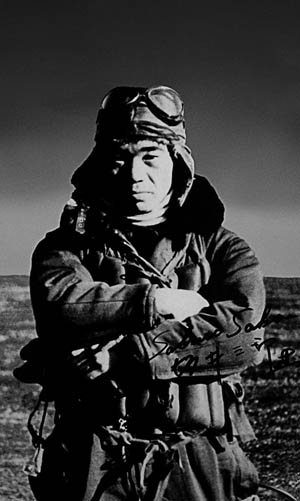
Unlike the F4F Wildcat fighter, U.S. Navy dive bombers were protected from rear attack by a tailgunner’s position. In the back seat of the aircraft piloted by Ensign Eldor E. Rodenburg, Aviation Radioman 3rd Class James W. Patterson, Jr., opened fire with his .30-caliber machine gun. “He came in fast! I fired at him, but I just don’t know if I hit him or not,” Patterson remembered.
Sakai attempted to turn sharply to the right, pull up, and use the Zero’s horsepower to climb away from the Americans, but he was too close. In the rear seat of one of the other bombers, Aviation Ordnanceman 2nd Class Harold L. Jones opened fire with Sakai only 100 feet directly astern of his aircraft.
What Jones saw next was a testament to the firepower that was available to the tailgunners: “His cockpit exploded, the canopy tore, and something flew out. I could see his face clearly, his body and head forced back against the headrest of the cockpit. The plane went almost vertically upwards and then fell smoking. That was the last I saw of him.”
As the eight tailgunners followed the Zero with their machine guns, slugs shattered the canopy glass and hit Sakai. Fragments from the bullets struck him in the chest, the left leg, the elbow, and the face. One tracer round missed his right eye by less than an inch and melted the rim of his goggles. In the brief encounter, the tailgunners expended over 1,000 rounds of ammunition and seriously injured one of the best Japanese fighter pilots of the war.
Making the Douglas SBD Dauntless
The Douglas SBD Dauntless was developed as an evolution of Northrop Aviation Corporation’s BT-1 and BT-2 dive bombers, which entered service in 1936. At that time, the U.S. Navy was transitioning from biplanes to all metal, low-wing monoplanes with retractable landing gear, and the BT series was on the cutting edge of that transition.
In 1937, Douglas Aircraft Company purchased Northrop Aviation’s El Segundo, California, factory and took over the BT program. With minor modifications by Douglas, the BT-2 Model 8 became the SBD-1 Dauntless in 1939, and deliveries of the aircraft began in June 1940. The basic airframe appearance of the Dauntless was established with the first model and would vary only slightly throughout production.
Its distinctive greenhouse canopy and round-tipped wings made it an easily identifiable aircraft. But perhaps the most recognizable feature of the Dauntless was its perforated dive flaps. In a steep dive, these flaps would deploy upward and downward from the trailing edge of the wing to maintain a constant airspeed of 250 knots. The three-inch perforations in the flaps allowed airflow to stabilize the aircraft, making the Dauntless a rock-solid bombing platform.
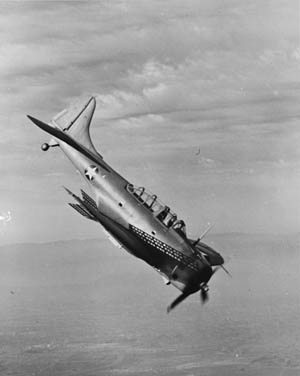
The SBD-1 was equipped with the powerful 1,000-horsepower Wright R-1820-32 radial engine, but it had an overall flight range that was considered too modest for aircraft carrier operations. For that reason, the SBD-2 was developed with an increase of 100 gallons in fuel capacity that extended the aircraft’s maximum radius from 860 miles to 1,125 miles.
The SBD was also a well-armed bomber. The pilot could control a pair of ANM2 .50-caliber machine guns mounted in the cowling, firing through the spinning propeller using an interrupter. The radio operator/tailgunner’s position was equipped with an aft-facing swivel mount for the ANM2 .30-caliber machine gun to protect the aircraft from a tail attack (as Saburo Sakai so painfully learned in the skies over Sealark Channel on August 7, 1942).
Most importantly, the Dauntless was built to deliver bombs with precision, so it was equipped with underwing ordnance mounting points. A pair of 100-pound bombs could be carried on outer wing pilings, and on the aircraft’s centerline a fork-shaped bomb-displacing gear allowed the mounting of 250-pound, 500-pound, and even 1,000-pound bombs. On release, the bomb-displacing gear would swing downward so that the bomb would clear the aircraft’s propeller, and a telescopic sight mounted in the cockpit allowed the pilot to aim the delivery of his underwing ordnance. In all, these features made the Dauntless a simple, effective, and rugged combat aircraft.
The ANM2 .30-caliber machine gun mounted in the tailgunner’s compartment was a weapon with the general physical appearance of a downsized M1919 series .30-caliber machine gun. With a smaller receiver, barrel, and barrel shroud than the M1919’s, the ANM2 weighed a mere 23 pounds as opposed to the 31 pounds of the M1919A4.
In addition to having a different receiver and barrel than the M1919 series, the ANM2 was equipped with a different feed cover, extractor, barrel extension, and bolt. These parts were specially engineered to allow the weapon to feed from either the left or right side of the receiver, a feature that made the ANM2 .30-caliber versatile for use in aircraft. A 100-round fixed ammunition box was attached to left side of the weapon to keep the belted .30-caliber cartridges from snagging the inside of the compartment.

The U.S. Marine Corps began operating the SBD-1 in 1940, and the Navy began using the SBD-2 in 1941. At about that same time, Douglas produced the SBD-3 version of the Dauntless with another increase in fuel capacity, extending maximum bombing range to 1,345 miles. This third model of the Dauntless entered service in March 1941 and also saw the introduction of self-sealing fuel tanks and armor protection for the crew.
The Navy began replacing its SBD-2s with SBD-3s immediately, handing the SBD-2s down to the U.S. Marine Corps. That process was still in motion when the Japanese attacked Pearl Harbor on Sunday, December 7, 1941, and the Dauntless went to war.
The SBD Dauntless Makes its Combat Debut
The Douglas SBD experienced combat from the very first day of the conflict, with the first losses the result of action with Japanese aircraft over Oahu. In the aftermath of Pearl Harbor, the Dauntless was one third of the team of aircraft that served on U.S. Navy aircraft carriers during the first six critical months of the war. Along with fighters and torpedo bombers, SBDs flew during each of the hit-and-run raids during the opening quarter of 1942.
American counterattacks on the Marshall Islands, Wake, and Marcus, as well as Lae and Salamaua on the west coast of New Guinea, included the Dauntless. When the aircraft carrier USS Hornet (CV-8) carried 16 Army B-25B Mitchell medium bombers for the Doolittle raid on Tokyo in April 1942, SBDs from the USS Enterprise (CV-6) flew combat air patrol to protect them.
In early May, SBDs from the aircraft carriers USS Lexington (CV-2) and Yorktown (CV-5) flew combat sorties during the Battle of the Coral Sea and contributed to the notable sinking of the Japanese light carrier Shoho near the Louisiade Archipelago on May 7, 1942.
During the Battle of the Coral Sea, the Dauntless proved that it was effective at the job it was designed for—search and strike. In addition to that, though, SBDs in the hands of skilled naval aviators during that battle proved that the aircraft was good at something else too: air-to-air combat.
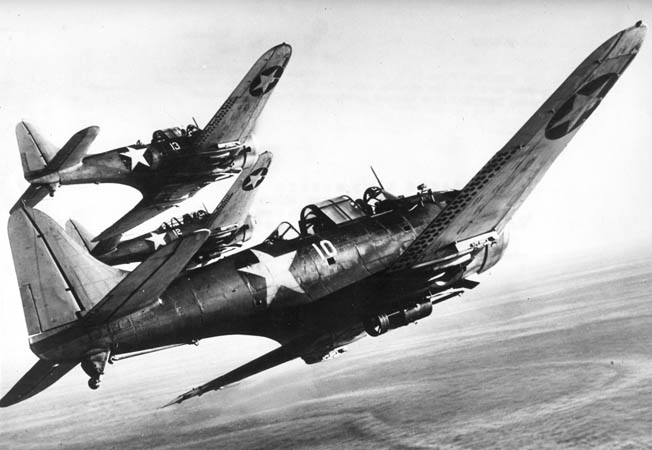
Air-to-Air in the SBD
On the morning of May 8, a section of SBD-3s was flying anti-torpedo-plane patrol to protect the Yorktown from enemy torpedo bombers. Lieutenant (j.g.) Stanley “Swede” W. Vejtesa, one of the pilots on the patrol, had put a 1,000-pound bomb through the deck of the Shoho the day before and was minutes away from still more excitement. Shortly after 11 am, the SBDs were attacked by a group of Zeros from the carrier Zuikaku. With superior speed and agility, the nimble Japanese fighters quickly brought down four of the SBDs, but then they came up against Swede Vejtasa.
After surviving the first attack, Vejtasa yelled to his radio operator/gunner: “Son, we’re in for a scrap—keep your head and conserve your ammunition. I’ll take care of the rest.” With guns blazing, the Zeros made pass after pass at Vejtasa’s SBD. Each time one of the enemy fighters attacked, Swede would turn into it and spoil the setup. Then Vejtasa would fire back at the attacker using the twin .50s in his engine cowling, while his radio operator/gunner in the back seat held off the enemy with his twin .30s.
Despite being harassed by three Zeros for an exhausting 25 minutes, Vejtasa’s SBD survived. And, although he was flying a dive bomber against fighters, Vejtasa miraculously shot down one of the Zeros.
SBDs fought air-to-air engagements with the Japanese time and time again during World War II and were credited with 138 victories. Clearly, the SBD was no ordinary dive bomber.
Lofton Henderson’s Douglas SBDs at Midway
Although it proved its mettle during the early hit-and-run raids and in history’s first carrier-vs.-carrier battle in the Coral Sea, the SBD’s finest hour came during the Battle of Midway in June 1942.
The Japanese descended on the battle area with naval might divided into a transport force, a main body, and an aircraft carrier striking force composed of the fleet carriers Kaga, Akagi, Soryu, and Hiryu. Their objective was twofold: capture Midway Island and lure the U.S. Navy task force off Midway into a final, decisive battle that would destroy it.
The U.S. Navy sent three fleet carriers into the battle area: the USS Enterprise (CV-6), Hornet (CV-8), and a battered and bruised Yorktown, each of which brought two squadrons of SBDs to meet the enemy.
The U.S. Marine Corps also contributed VMSB-241, a scouting/bombing squadron that included 19 SBD-2s. The Marine aviators who fought in the battle all flew from the naval air station on Eastern Island, Midway. They were led into combat by 39-year-old Major Lofton R. Henderson.
A 1926 graduate of the U.S. Naval Academy, Henderson flew at the front of the squadron’s attack against the Japanese carrier strike force on June 4. The squadron took off from Midway at 6:10 am and flew to the northwest side of the island. By 7:55 am, it was within sight of the Japanese fleet and under attack by Zero fighters of the enemy’s combat air patrol.
Major Henderson led VMSB-241’s SBDs on a gently sloping glide-bombing attack on the aircraft carrier Hiryu from an altitude of 4,000 feet. His SBD was among the first shot down by the enemy’s fighters—the American airfield at Guadalcanal would be named in his honor. (Today it is known as Honiara International Airport.)
Although their commander was lost early on, the men of VMSB-241 drove home the attack on the Hiryu. One of the bombers pressing forward in the middle of the chaos of antiaircraft fire was SBD-2 #2106 piloted by 1st Lt. Daniel Iverson, Jr. As he dove toward the target through a thin cloud, two Zeros followed him.
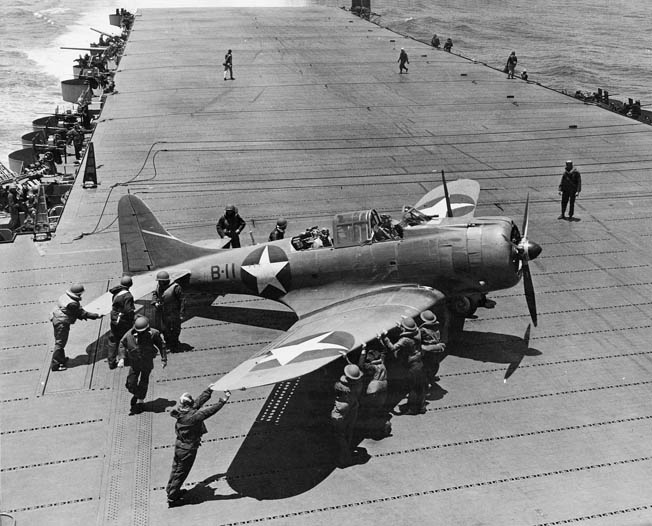
How the SBD Dauntless Fared When Dueling With Zeros
In the back seat of the Dauntless, Pfc. Wallace J. Reid fired burst after burst from his single ANM2 .30-caliber machine gun. With a pair of unrelenting fighters directly in his field of fire during the dive, Reid hammered away with his gun as Iverson’s plane fell almost vertically toward the target. At the appropriate moment, Iverson hit the release switch at an altitude of 300 feet above the Hiryu, and the displacing gear dropped the 500-pound bomb away from the aircraft.
The young pilot then leveled off close to the water, closed his dive-flaps, opened his cowl flaps, and pushed the throttle forward as far as it would go. The engine surged to 2,300 rpm. As #2106 raced away from the Hiryu, two more Japanese fighters joined the chase as Pfc. Reid desperately struggled to hold the attackers at bay with his ANM2.
Japanese bullets peppered the SBD’s horizontal stabilizer, rudder, wings, and empennage. One round slammed into the instrument panel, disabling the airspeed indicator. Another round severed the aircraft’s hydraulic system. Despite Reid’s best efforts to defend the Dauntless, bullet fragments wounded both him and Iverson.
After what seemed like an eternity, the Japanese fighters that had been hounding #2106 finally broke off their attack and turned back toward the fleet. A bleeding Lieutenant Iverson brought the aircraft back to Midway and made a crash landing. After he shut his engine down and he and Reid had jumped to safety, Iverson was surprised to see that there were some 250 bullet holes in the aircraft. As #2106 proved, the SBD Dauntless was rugged, reliable, and capable of absorbing lots of punishment.
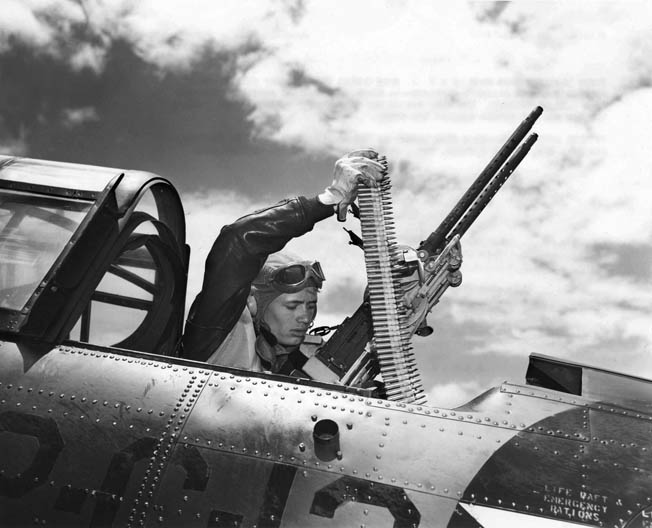
VMSB-241 paid a heavy price for its attack on the Hiryu—eight of the 16 SBDs that flew the mission were lost to enemy action. Reid subsequently received the Distinguished Flying Cross for his persistent courage and determination during the harrowing flight. Major Henderson and 1st Lt. Iverson both received the Navy Cross for leading an attack “which contributed materially to the defeat of the enemy.”
The Japanese Weather the American Attacks
Although the Hiryu sustained no significant damage, VMSB-241 did indeed make a material contribution to victory in the Battle of Midway. The Marines’ strike against the Japanese fleet was part of a cascading series of attacks from various land- and carrier-based Army and Navy squadrons.
Before VMSB-241 arrived on the scene to harass the Japanese carriers, Navy Grumman TBF-1 Avenger torpedo bombers and Army Martin B-26 Marauder medium bombers had already been there. After Henderson’s SBD-2s made their attack and departed the area, a group of Army Boeing B-17 Flying Fortress bombers struck, followed by a group of 11 SB2U-3 Vought Vindicator dive bombers (also from VMSB-241).
All of these attacks were conducted by land-based aircraft and took place between 8 and 8:20 am on June 4. Although brief and responsible for almost no damage, these attacks forced the Japanese ships to maneuver defensively, caused their antiaircraft gunners to expend large quantities of ammunition, and made their combat air patrol planes burn fuel. For the next hour, the Japanese carriers were able to recover aircraft and begin the process of rearming and refueling, but then American carrier-based squadrons began a new series of attacks.
At approximately 9:20 am a formation of 15 Douglas TBD-1 Devastator torpedo planes from the USS Hornet began an attack on the carrier Soryu. With no fighter escort to protect them from the nimble Zeros, all 15 of the slow-moving TBDs were easily picked off within a matter of minutes; they did no damage to the enemy fleet. At 10 am a formation of TBDs from the Enterprise commenced an attack. Fifteen minutes later, TBDs from the Yorktown closed in on the Hiryu.
Once again the Japanese fleet dodged the bullet and suffered no meaningful damage. But the cumulative effect of fighting off enemy aircraft for more than two hours stretched the Japanese to the limit. Although they had been successful in defending their carriers, their luck was about to run out.

Destruction of the Japanese Carrier Force
The true decisive moment of the Battle of Midway began just as the Yorktown TBDs were concluding their attack. As Japanese gunners and combat air patrol fighters attempted to bring down the last of the Devastators escaping at wave-top level, lookouts on the Akagi noticed American aircraft high above the fleet. It was 10:22 am on June 4, 1942, and the course of World War II was about to be changed by 48 SBD Dauntless dive bombers.
At that moment, 25 SBD-3s from the Enterprise entered their dives in an attack on Kaga that quickly resulted in four direct hits. Moments later, six more Enterprise SBD-3s dove on Akagi and scored two direct hits with lethal 1,000-pound bombs. Simultaneously, 17 Yorktown SBD-3s dove on Soryu, scoring three hits with 1,000-pound bombs.
In four minutes’ time, three Japanese fleet aircraft carriers—each of which had participated in the Pearl Harbor raid—were raging infernos. A group of 13 SBDs flew from the Enterprise (10 of which belonged to the Yorktown’s air group) and found the Hiryu later that afternoon, hitting it with four 1,000-pound bombs, destroying it as well.
Thus the Japanese ended the day on June 4, 1942, having lost all four of their aircraft carriers to American SBDs. It was so significant a loss that it materially altered their battle plan. Admiral Yamamoto ordered a general retirement from the battle area that night.
Turning Point in the Pacific Theater
With the cancellation of the plan to capture Midway and the obvious failure to destroy the U.S. Pacific Fleet in a final, decisive showdown, the Japanese conceded defeat. Although technically the battle was over, the Dauntless was not quite done destroying ships.
The next day, June 5, U.S. forces pursued the retreating Japanese westward as they withdrew in defeat. Since all four Japanese aircraft carriers were now on the bottom of the sea, the cruisers Mikuma and Mogami offered the most tempting targets as they limped away at 15 knots. Having collided with Mikuma the night before, the Mogami was struggling with damage that caused a dramatic reduction in speed. Accordingly, SBDs from VMSB-241 launched an attack against the two ships the morning of the 5th, but they scored only near misses that slightly damaged Mikuma.
The following morning, June 6, a strike of 81 SBDs from Hornet and Enterprise found the two enemy cruisers and attacked them in three waves. After being hit by two 1,000-pound bombs, Mogami sustained additional damage but lived to fight another day. Hit by three 1,000-pound bombs, the Mikuma was reduced to a burned-out hulk dead in the water. The ship sank later that evening, marking the end of the battle.
The tally of Japanese losses was staggering: 248 combat aircraft and just over 3,000 men had been lost. Four fleet aircraft carriers and one cruiser had been sunk. The Akagi, Kaga, Soryu, Hiryu, and Mikuma had all been destroyed by the Douglas SBD Dauntless. (Get an in-depth look at these and other critical events in the Pacific Theater by subscribing to WWII History magazine.)
Prior to Midway, the Japanese were in the process of expanding a vast oceanic empire. After Midway, the Japanese transitioned to a defensive posture and began to fight the only war they could not possibly win, a protracted war of attrition. Together with El Alamein and Stalingrad, Midway was a turning point in World War II. The slow but deadly (SBD) Dauntless was the primary weapon that made this possible.

The Navy’s Douglas SBDs After the Battle of Midway
Although the Battle of Midway was definitely the Douglas SBD’s finest hour, the aircraft continued to serve prominently through the tumultuous events of 1942. Navy and Marine Corps SBDs participated in the Guadalcanal campaign as land-based anti-ship and ground attack platforms during the closing months of the year.
Carrier-based SBDs from the USS Enterprise and the USS Saratoga (CV-3) fought the dramatic Battle of the Eastern Solomons on August 24 and 25. In October, SBDs from the carriers Enterprise and Hornet fought in the Battle of Santa Cruz.
Then, in November, on the other side of the globe, SBDs from the carrier USS Ranger (CV-4) flew air support for the Operation Torch landings in North Africa. On November 10, 1942, nine SBDs from the Ranger sank the moored French battleship Jean Bart in port at Casablanca, Morocco. With the sinking of the Japanese battleship Hiei three days earlier in the Pacific, this was the second enemy battleship sunk by SBDs within one week.

The A-24 Banshee: the Army’s Douglas SBDs
During the early part of the war, the Army also used the Dauntless under the nomenclature A-24 Banshee. Essentially an SBD-3 without a tail hook, the A-24 replaced the SBD’s solid tail wheel with a large pneumatic tire. The Banshee entered service in March 1941 but had a far less distinguished career flying for the Army.
When the war began, the A-24 was to equip the USAAF’s 27th Bombardment Group in the Philippines, but the surrender of Bataan saw the Banshee diverted to Australia, where it equipped the 91st and 8th Bombardment Squadrons of the 27th Bomb Group. The 91st Bombardment Squadron took its aircraft to the Dutch East Indies, and the 8th Bombardment Squadron operated from the north coast of Australia.
As the Navy model changed, so did the Army model. In late 1942 the Navy SBD-4/Army A-24A began to enter squadron service with only minor changes from the previous model. By that point in the war, the Army was no longer using the Banshee in combat, but the SBD-4 went into full fleet carrier service. When the Curtis SB2C Helldiver entered service in late 1943, the Dauntless was no longer the Navy’s frontline dive bomber.
Despite that, the most produced variant of the aircraft was introduced at about that same time. The SBD-5/A-24B featured an increased ammunition-carrying capacity, an illuminated bombsight, and also introduced the 1,200 horsepower Wright R-1820-60 engine. A total of 3,640 SBD-5s/A-24Bs were produced during 1943 at the height of industrial production in the United States. These aircraft went on to fight some of the most dramatic encounters of the latter years of the war.
During this period, carrier-based Navy SBD-5s participated in raids against the Japanese garrison on Wake Island (October 1943) as well as the Operation Hailstone raid against the Japanese fleet anchorage at Truk lagoon in February 1944. The Dauntless also fought north of the Arctic Circle when SBD-5s from the Air Group of the USS Ranger participated in Operation Leader, a strike against German shipping in Bodo Harbor, Norway, on October 4, 1943.
Phasing Out the SBD Dauntless
Since the Army was no longer using the Banshee in combat, some A-24s were turned over to the USMC for land-based operations. Some of these aircraft flew antisubmarine patrols over the Caribbean from a base in the Virgin Islands, while others assigned to VMSB-236 participated in a raid on Rabaul on January 14, 1944.
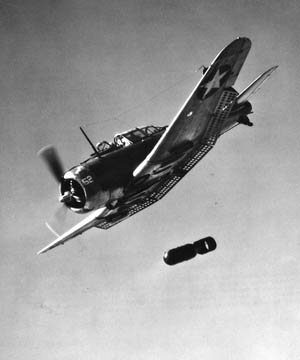
The introduction of the SB2C Helldiver and the SBD’s lack of folding wings resulted in its gradual disappearance from Navy carrier air groups during 1944. The last major aircraft carrier operation it flew came on June 20, 1944, when SBD-5s from the Enterprise and the reborn Lexington (CV-16) flew a strike against the Japanese during the Battle of the Philippine Sea.
The following month, when SBDs flew in support of ground forces fighting to liberate Guam, it marked the conclusion of the aircraft’s shipboard service. At about that same time, the final version of the Dauntless was introduced as the SBD-6. Although the most powerful and advanced variant of the series, the 450 SBD-6s produced mostly remained stateside.
Meanwhile, SBD-5s continued to serve in land-based squadrons overseas until the end of the conflict. For example, Marine Air Group 12 (MAG-12) moved to the island of Luzon, Philippines, shortly after the amphibious landing of Army forces at Lingayen Gulf in January 1945. SBDs assigned to MAG-12’s famous VMSB-241—best known for its stunning performance almost three years earlier during the Battle of Midway—flew numerous combat sorties in support of Army units on the ground until V-J Day in August.
At the end of the war, the SBD Dauntless had many claims to fame, the most impressive of which was that it sank more Japanese shipping in the Pacific than any other Allied aircraft. The SBD Dauntless could also claim the lowest loss ratio of any U.S. Navy carrier-based combat aircraft in World War II.
When one considers that each example of the aircraft responsible for the miracle at Midway was costing the U.S. government a mere $29,000 in 1944, one must recognize that the Douglas SBD Dauntless was truly one of the greatest aircraft of World War II.
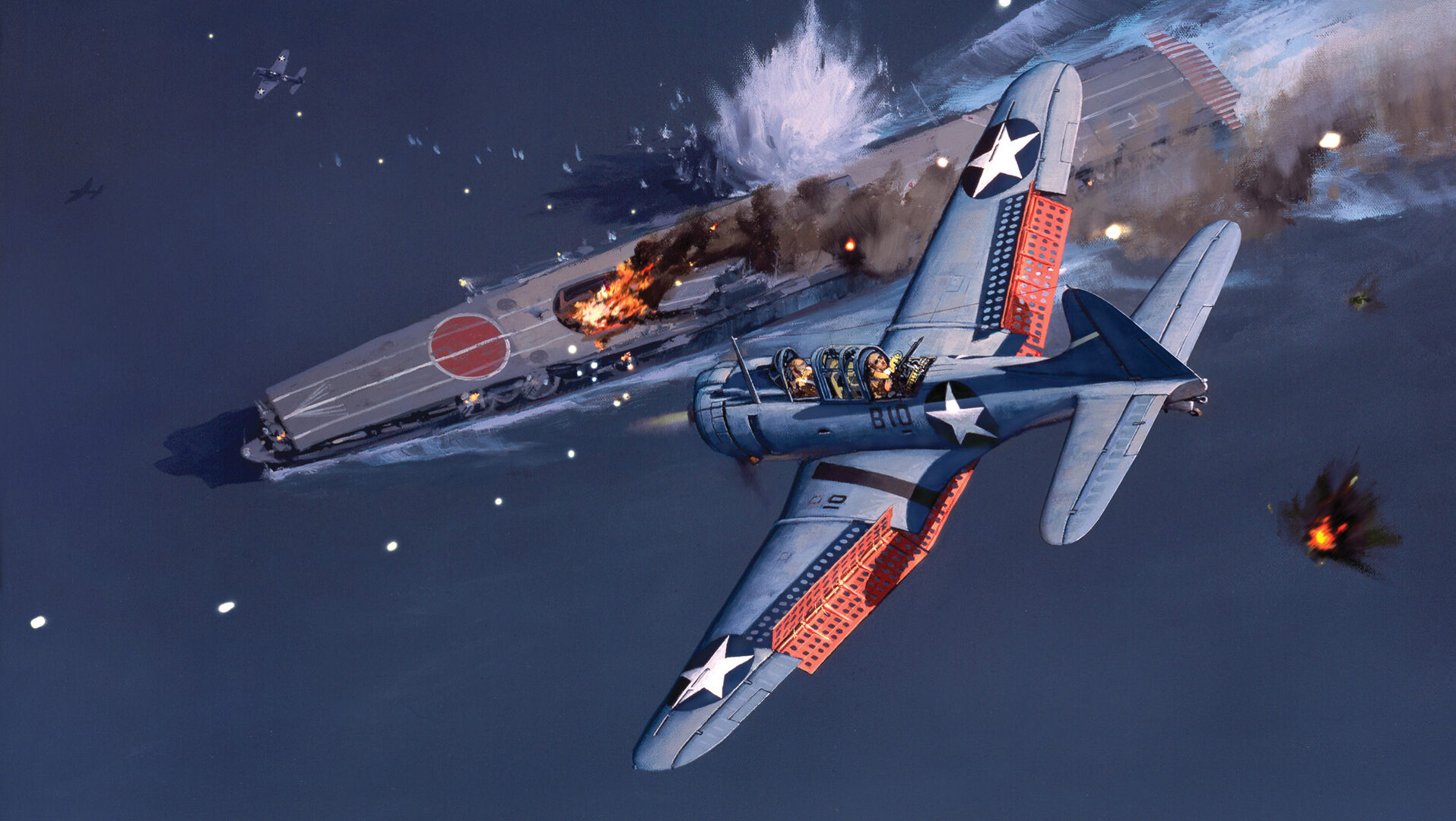
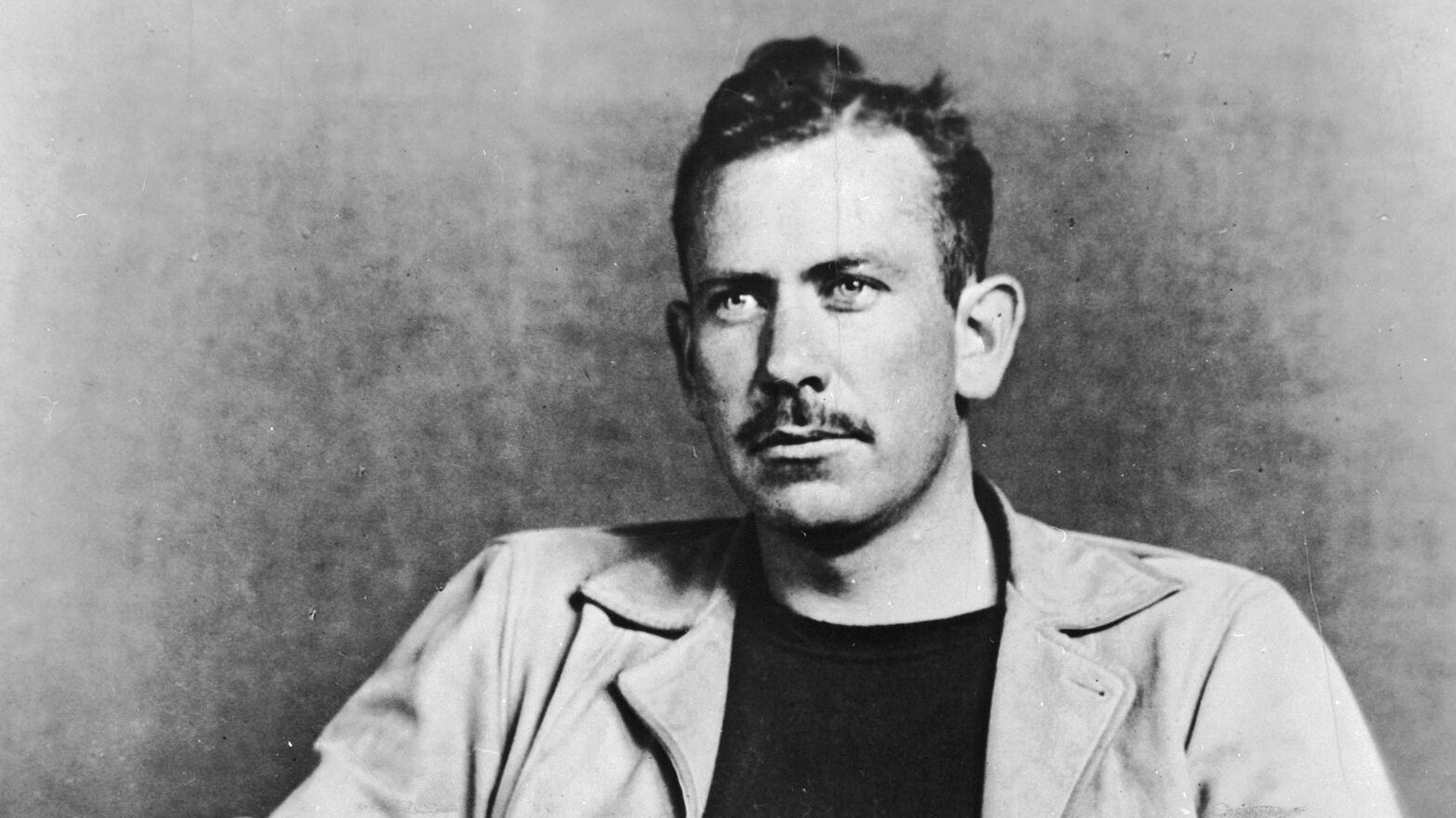
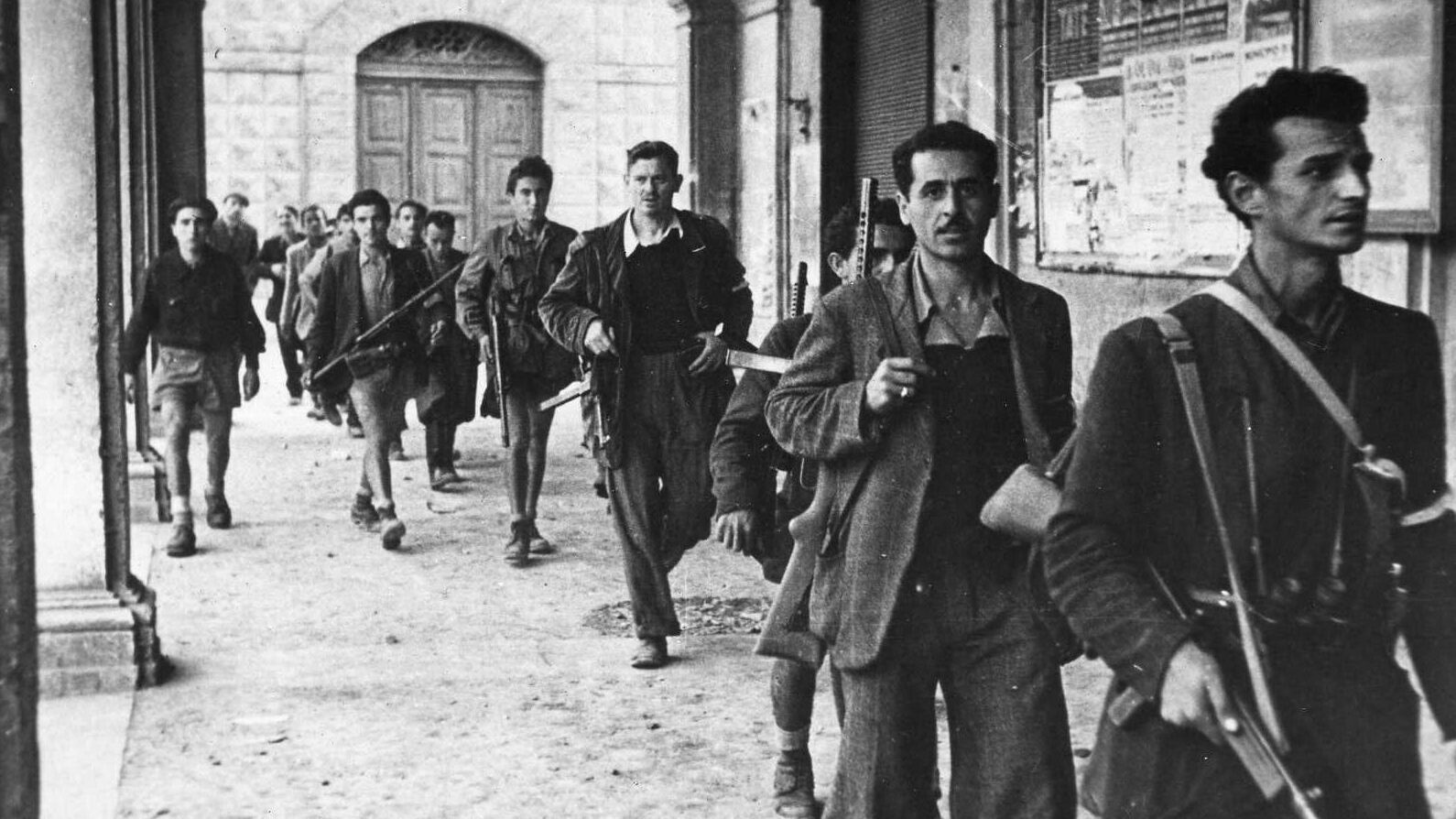
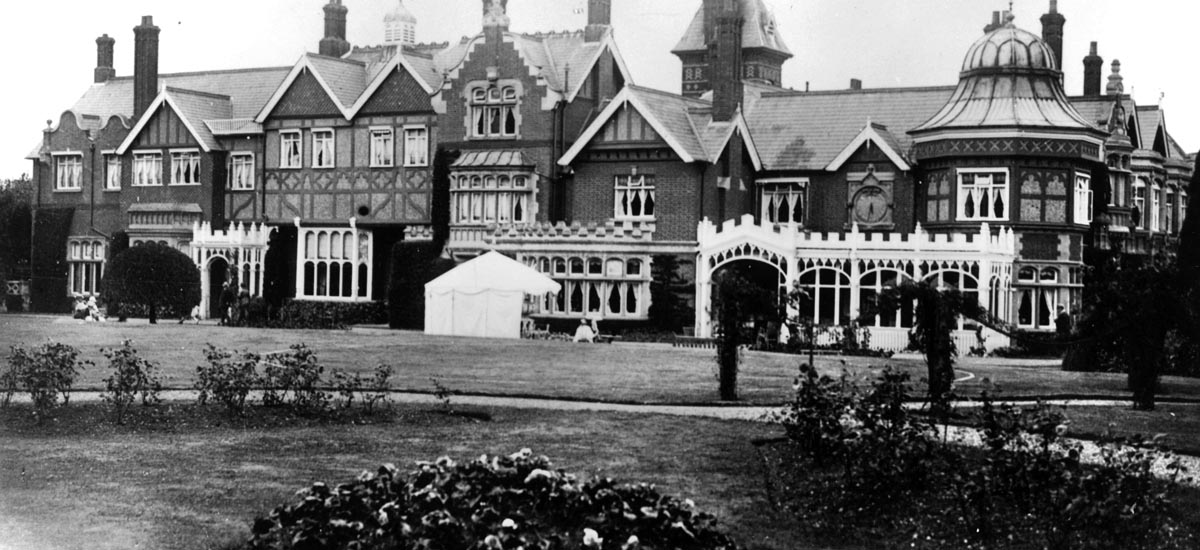
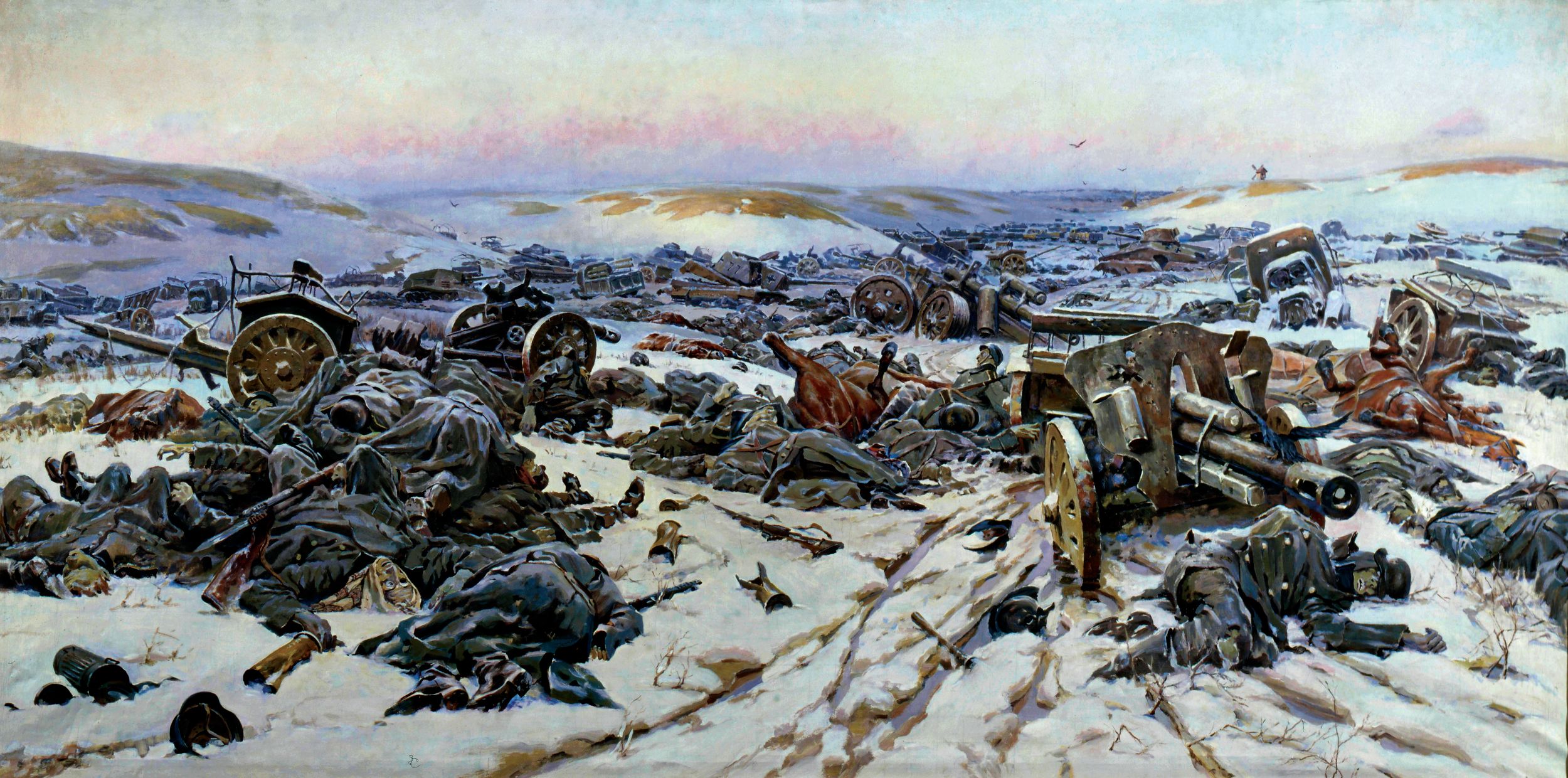
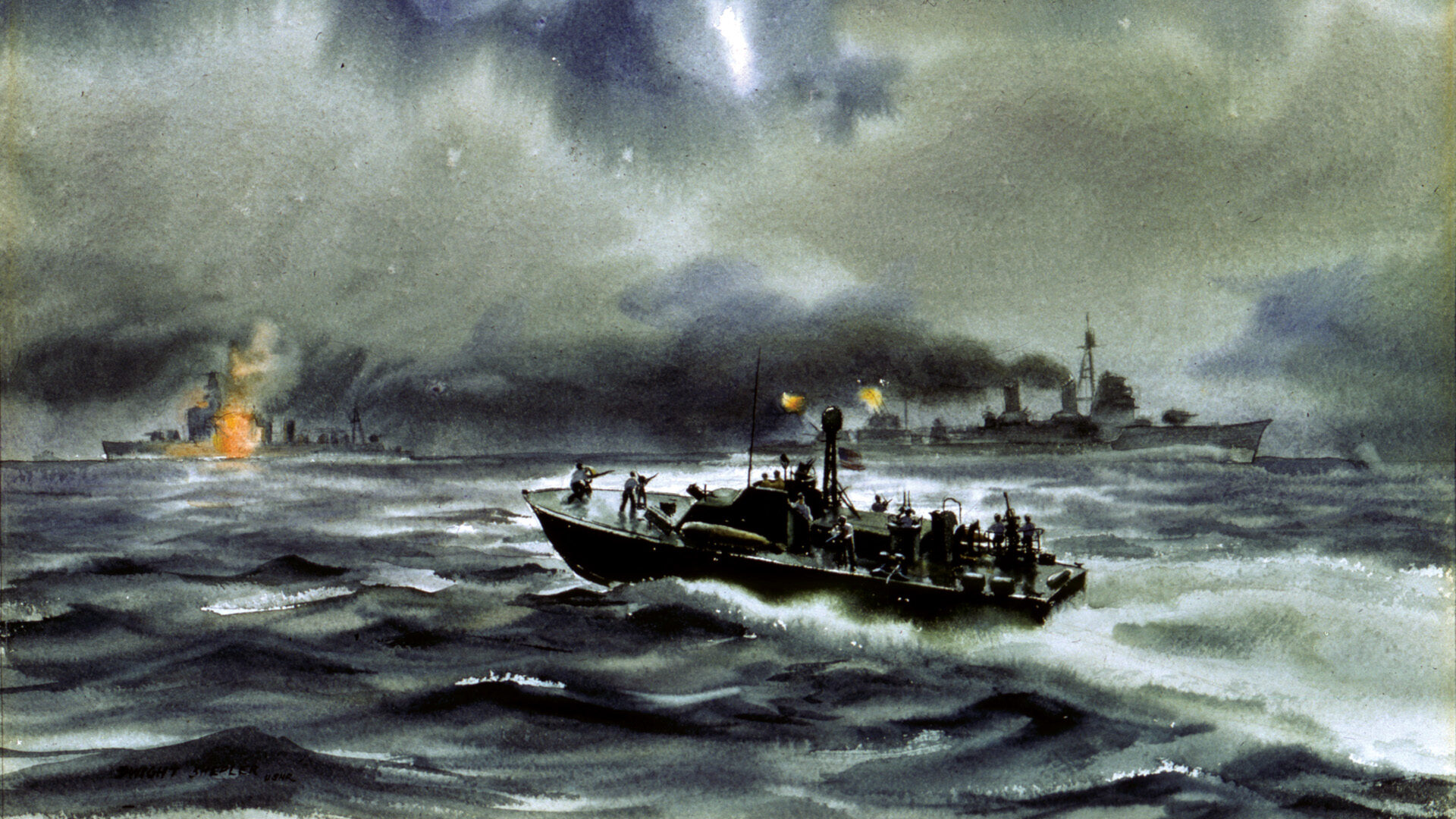
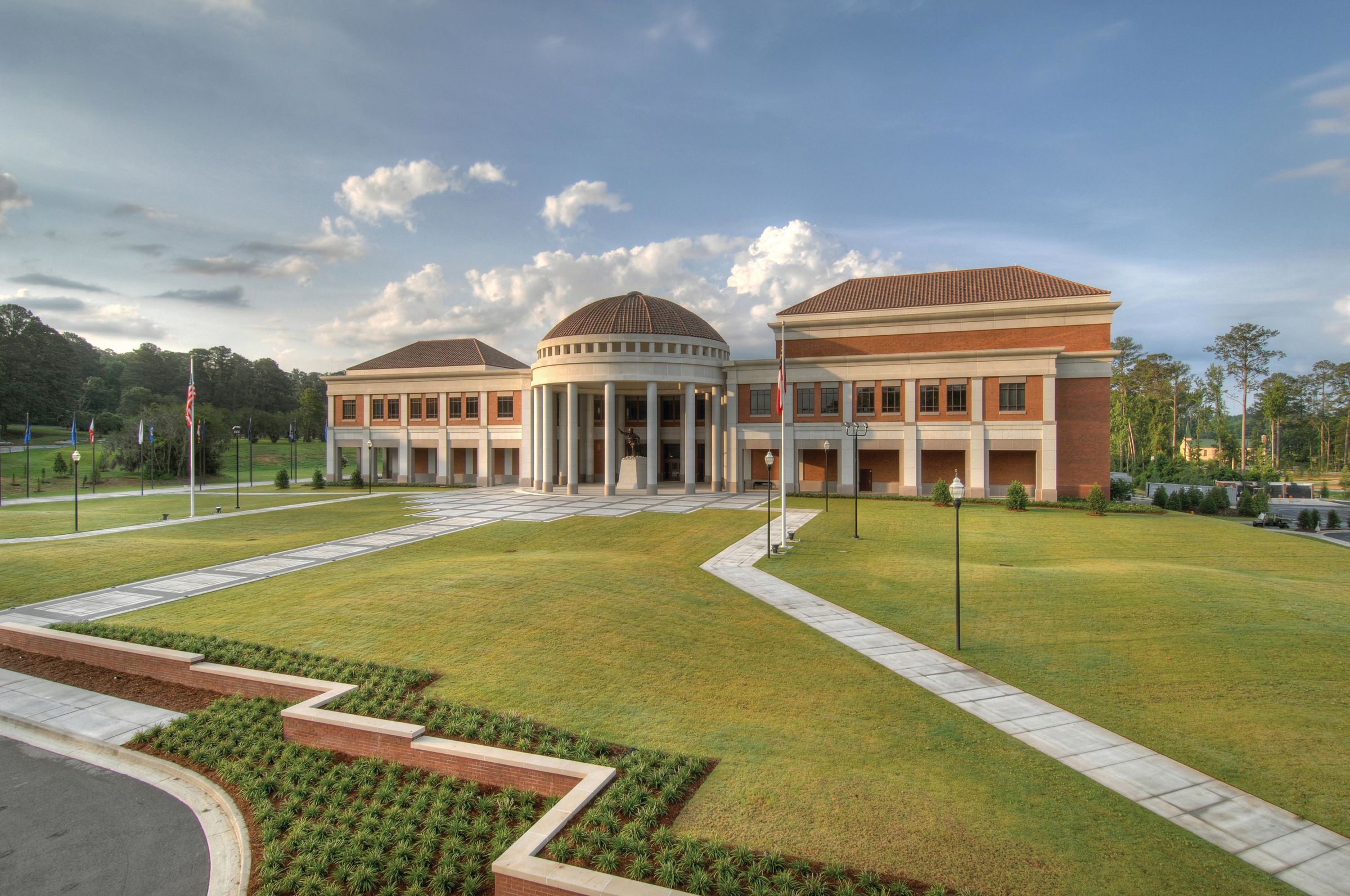
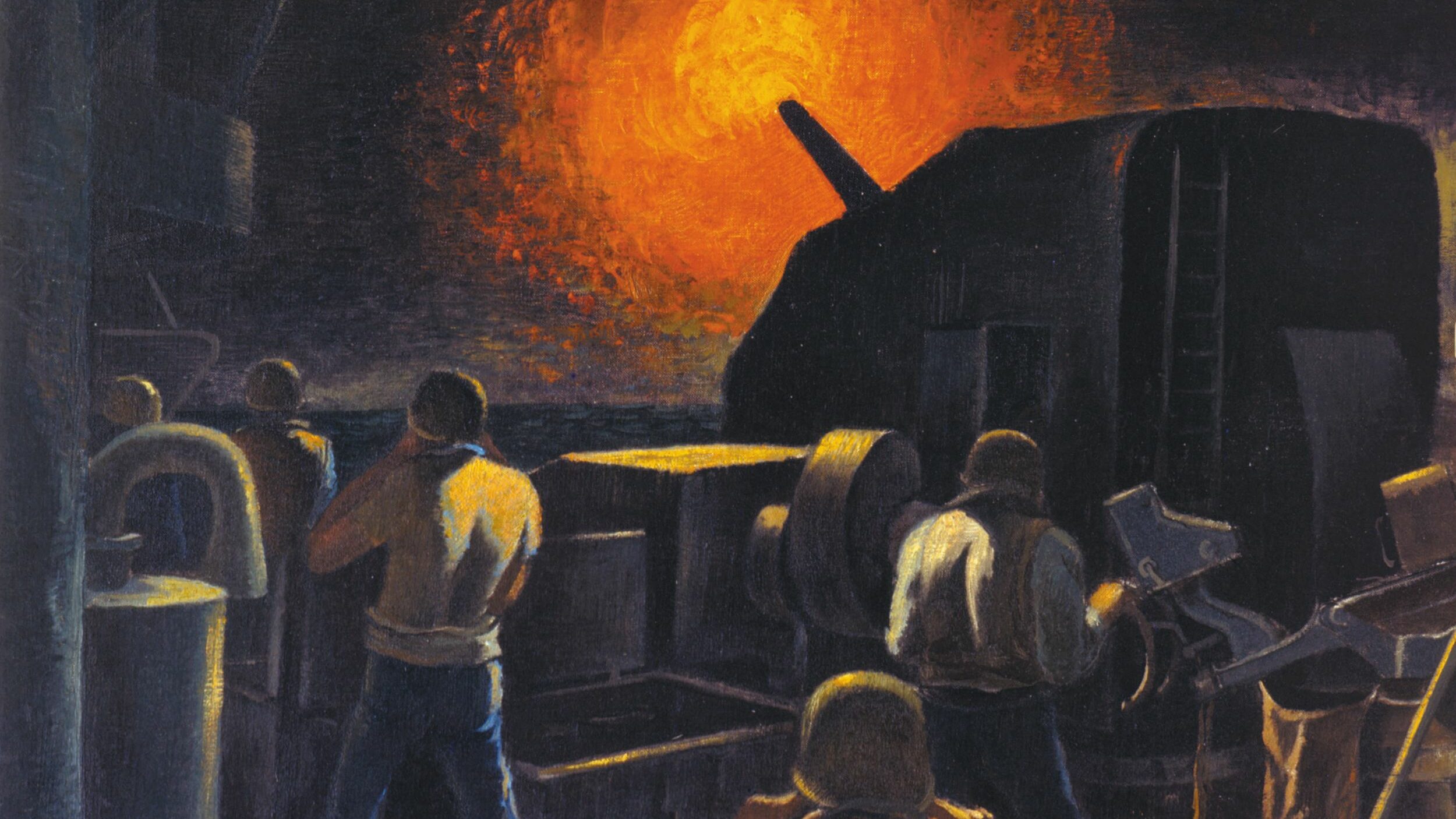

Interesting that the accounts of engaging Sakai’s Zero are from the SBD side of the story. It could’ve been another Zero. During that mission Sakai was gravely injured, but did return to base. So he was not “shot down.” He spent considerable time home in Japan recovering.
However, in his autobiography that I read 60 years ago he is VERY clear that he approached these aircraft from astern & a bit below and they turned out to be TBM’s (Enterprise also had VT-6 aboard) that were likely loaded with bombs. The fire that got him came from the Avenger’s belly gun position and others in the formation that could’ve brought that stinger to bear.
I tend to believe Sakai as he was extremely experienced even in ’42 and possibly could’ve mistaken a TBM for a Wildcat, given the fuselage and wingtip profiles, versus the prettier & more rounded lines of the Dauntless.
Indeed, when people on the ground—who had never seen the Avenger— asked what it looked like, the answer was “like a pregnant Wildcat.”
I have been impressed by the SBD ever since I First read about it years ago!
Each year in August our whole family vacations in Pensacola, Florida and up until the past two years, we Always visit the Navy Museum on the Base, and I explain to our children how this Beautiful little SBD changed the course of WWII, my dad and three Uncles fought in the South Pacific during the War, and Only by the Grace of God and the Atomic Bombs, survived to come home!
Never was there a poignant war story but that some nay-sayer will
feel the need to step forward to pour cold water on it. This time is
no exception.
HL
The thing that really chimed the death-bell for the SBD in carrier operations was its’ lack of folding wings. Almost universally, the SB2C Helldiver was loathed by its’ crews, and many also pined to return to the SBD. The SB2C Helldiver had an interesting nickname that illustrated how it was regarded by the fleet…”Son-Of-A-Bitch, Second Class.”